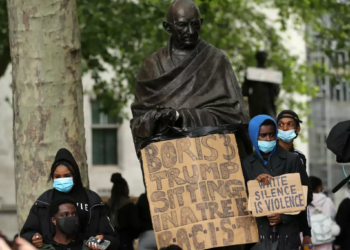Faizuddin is still traumatized from the lightning strike that killed his three friends as they took selfies atop a 400-year-old fort in India, where climate change is making lethal strikes more common.
Scores of people have met similarly gruesome ends this year in the western desert state of Rajasthan, where deaths caused by thunderstorms used to be uncommon.
“I was hit by three thunderbolts, one after the other,” said Faizuddin, his voice quivering as he lay wrapped in a blanket at his modest home in Jaipur.
He and his trio of childhood friends had climbed hundreds of steps to a watchtower on top of Amer Fort during a July storm that also claimed eight other lives.
“The sound was deafening, it felt like a huge bomb blast. My trousers and shoes caught fire, my limbs became stiff and I couldn’t move,” the 21-year-old told AFP, a deep gash still on his head.
Around 2,500 people die in lightning strikes around India each year, according to government figures, compared to just 45 in the United States.
Cattle and other animals are often killed or maimed during severe thunderstorms, with one burst of lightning in northeastern Assam state wiping out a herd of 18 elephants in May.
Thunderbolts contain as much as a billion volts of electricity and can cause immense damage to buildings when they hit.
Earlier this year at another fort in Chittorgarh, a few hours south of where Faizuddin’s friends died, a bolt struck a tower and sent a huge chunk of stone plummeting to the ground.
The site was fitted with a rod to draw lightning away from the centuries-old structure “but it proved to be ineffective,” said Ratan Jitarwal, a conservator supervising the fort’s painstaking repair work.
‘A sudden surge’
Lightning is also becoming more frequent, with nearly 19 million recorded strikes in the 12 months to March — up by a third from the previous year.
Global warming is driving the increase, says Sanjay Srivastava of the Lightning Resilient India Campaign, one of the few organizations collecting data on thunderstorms.
“Because of climate change and localized heating of the Earth’s surface, and more moisture, there is a sudden surge of huge lightning,” he told AFP.
The problem is worldwide, with research this year forecasting a possible doubling of the average number of lightning strikes inside the Arctic Circle over this century.
This could spark widespread tundra fires and trigger massive amounts of carbon stored within the permafrost escaping into the atmosphere, exacerbating global warming.
Evidence suggests lightning strikes are also becoming more common in urban areas — a particular concern in India, where the city population is forecast to rise dramatically in the coming years.
Srivastava said the results could be catastrophic if, for example, a strike hit a hospital and shorted out equipment used to keep patients on life support in intensive care.
‘Devil came from the sky’
As with rising sea levels, the growing frequency of deadly heatwaves and other consequences of climate change, the country of 1.3 billion people is struggling to adapt to the threat of worse lightning strikes.
Most human deaths in thunderstorms are preventable but almost no buildings have lightning rods to protect their inhabitants, Srivastava said.
Forecasting is also tricky and warning people of approaching storms is difficult.
Indian scientists recently developed a mobile app that seeks to provide real-time warnings about imminent strikes and precautions to be taken.
But this has limited use in a country where only half the population has access to a smartphone, and even fewer in rural areas where strikes are more common.
Many people are also unaware of the dangers and what to do — like not to shelter under a tree and avoiding open areas — in a thunderstorm.
“Had we known that lightning strikes… can kill and maim, we would have never allowed our son to step out of the house,” said Mohammed Shamim, whose 20-year-old son died in the Amer Fort incident.
“He had worn a new shirt that day and all he wanted was to take some nice shots on his phone. But it feels as if some devil came from the sky and took our son away.”
























